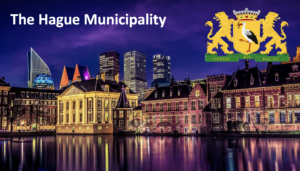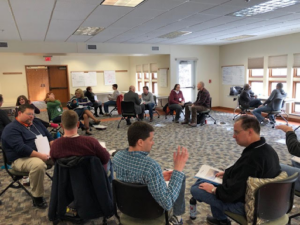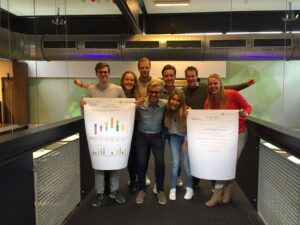How BGK’s strategy implementation transformed
its organizational culture
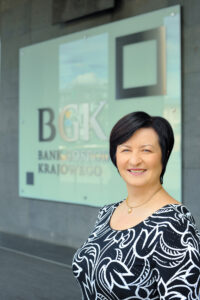 All organizations can explain what they do. Some can also show how they are different from others. However, only a few know why they do something. This is Simon Sinek’s thesis in his bestseller How Great Leaders Inspire Others to Act. The “why” here has little to do with profit or finances. It is about what inspires you and impacts those around you.
All organizations can explain what they do. Some can also show how they are different from others. However, only a few know why they do something. This is Simon Sinek’s thesis in his bestseller How Great Leaders Inspire Others to Act. The “why” here has little to do with profit or finances. It is about what inspires you and impacts those around you.
A few years ago, Bank Gospodarstwa Krajowego (BGK) needed to change the ways in which the company was managed and business objectives were pursued. Its existing business practices had become ineffective and no longer obtained the desired results and improvement. BGK saw the need for completely new implements to enable the achievable transformation that would be adopted at every level of the organization.
WHY THE TRANSFORMATION?
Bank Gospodarstwa Krajowego was established in 1924 on the initiative of the Prime Minister and Minister of the Treasury, Władysław Grabski. It is a state-owned development bank – the only such institution in Poland. The bank currently has representative offices in Brussels, London, Frankfurt am Main and Amsterdam.
The cultural transformation at Bank Gospodarstwa Krajowego started in 2017. First grassroots initiatives were already emerging, showing the need for further change. Defining the key areas of transformation, tracking changes in business environment, and monitoring economic metrics allowed us to set the right course for change. Those measures resulted in developing BGK’s strategy for 2017–2020 by the board and management.
We understood that without questioning our existing practices, transformation would not be possible. Once the lack of improvement and the need for new tools to enable acceptable cultural transformation organization-wide had been clearly proved, BGK’s management realized the need for change and did not hesitate to form a creative environment which turned out to be crucial in the adoption of new rules of conduct.
DISCOVERING VALUES
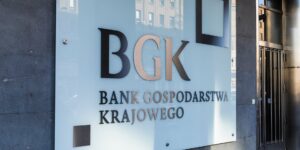 Values have proved to be such a new tool – the most essential binder of culture that, when understood properly, creates and integrates the new DNA of an organization, unifying its interior and creating a coherent image of its exterior. We acknowledged that professionalism, teamwork, and commitment were values that permeated the inside of our organization. Dissecting these into specific behaviors has reaffirmed the direction we want to take as BGK.
Values have proved to be such a new tool – the most essential binder of culture that, when understood properly, creates and integrates the new DNA of an organization, unifying its interior and creating a coherent image of its exterior. We acknowledged that professionalism, teamwork, and commitment were values that permeated the inside of our organization. Dissecting these into specific behaviors has reaffirmed the direction we want to take as BGK.
We assumed that differentiating the behavior descriptions at management level would help establish the right metrics and contribute to effective employee evaluation at a later stage. The entire evaluation system was based on the employee’s behaviors and the values these represented. Changing the periodic appraisal system meant a transformation in terms of communication, implementation and evaluation of the whole system.
The challenge for managers was to properly assess employees’ attitudes, as well as to be ambassadors for the changes taking place in the bank. This required understanding the point of those who sometimes asked, “what for?” In hindsight, however, it is important to emphasize that everyone who dared to challenge the status quo at the time and asked difficult questions ultimately contributed to the success of the endeavor.
It was not immediately obvious that regular meetings with the team, cascading goals and delegating tasks were the future in a changing world. Today, the realities of VUCA and BANI are a part of our reality. However, let us not forget that not so long ago the approach to management was different. Hardly anyone thought about changes if the model in place was working and doing well.
As a development bank, we have always set the bar higher. By opting for the NEWS® Navigation tool, we moved closer to the target model and pointed to the key role of managers in implementing values into the organizational bloodstream. These were our executives with whom we wanted to build the cultural transformation of our organisation, believing that their competences and attitudes would be the basis for the development of the entire company. This is also what happened.
We prepared an entire development program that built consistency in the terminology of our approach to developing employees and teams at every level of the organisation. This meant that we all spoke the same language. We opted for Maxwell’s 5 Levels of Leadership model, because we had to have a benchmark to aim for. Our entire organization, starting with the board and ending with line managers, have completed the full course. We implemented a consistent leadership model across the organization. After almost three years, we saw that all the indicators we had identified when building the strategy were achieved.
HOW ARE WE DIFFERENT FROM OTHERS?
 Our new strategy is the result of a thorough analysis of the social, economic and business changes that are taking place in Poland, Europe, and the world.
Our new strategy is the result of a thorough analysis of the social, economic and business changes that are taking place in Poland, Europe, and the world.
This latest business strategy sets out BGK’s ambitions and goals for 2021–2025. BGK continues to pursue its mission defined by its founders almost a century ago. Additionally, we wish to significantly revise it and place emphasis on supporting the country’s sustainable social and economic development, providing future generations with better living conditions and opportunities for further growth.
The Bank’s new strategy strongly accentuates the second element of its mission – social development, which influences the building of our country’s social capital. Without building social capital, inspiring and activating local communities, supporting intellectual capital, promoting healthy lifestyles through sport or environmentally friendly behaviour, it is impossible to develop the economy. Society and economy act as communicating tubes.
LEADER IN DEVELOPMENT
As we launch our new vision in 2021, we want to be seen as a leader in sustainable development programs; we wish to inspire and create solutions that bring the private, public and financial sectors together in these efforts.
Becoming a development leader at a national level also requires a continuous transformation within the organization. It has become clear that rigid attachment to the existing structure does not give sufficient space for developing innovative solutions. Interdisciplinary and cross-area working became a priority in the learning organization system. A focus on systemic and contextual thinking brought employees closer to finding solutions that combined knowledge and experience from different areas, and the results provided an answer to the challenges of tomorrow. At the same time, we understood that we had to bet on three new values: openness, teamwork, and responsibility. These we understand as:
– We talk openly about what works, what doesn’t work, what needs to be done; I am able to engage not only in what concerns myself, but in something that has greater value; collaboratively, combining competences from different parts of the organisation; and
– I take responsibility for what I do and for what I contribute.
The new value of teamwork indicates that only in synergy with others can we create something bigger. We already knew that we were supposed to respect each other, that we were supposed to have an appreciation for each other, that we should listen to each other – but here is where action comes in. We act as a team, relying on project work between departments, and here is where the need arises to implement a matrix model of management. In order to do this, we needed to further streamline communication in the organization and strengthen the culture of taking responsibility.
TOOLS FOR MEASURING ORGANIZATIONAL CULTURE
 To support our development, we needed a tool that would measure the current organizational culture in multiple dimensions simultaneously and show us in which directions to change it. As a development bank, a role model for Central European development banks, we needed an international tool that was proven across different industries and cultures. We aspire not only to be a leader, but also to learn from the best.
To support our development, we needed a tool that would measure the current organizational culture in multiple dimensions simultaneously and show us in which directions to change it. As a development bank, a role model for Central European development banks, we needed an international tool that was proven across different industries and cultures. We aspire not only to be a leader, but also to learn from the best.
The first step was to research organizational culture using ValueMatch assessments, which are based on the Spiral Dynamics model. Spiral Dynamics defines a set of value systems that drive people and determine how they view life and their work and the ValueMatch instrument measures which values drive the people and which values are expressed in the company culture. In collaboration with the Kirov & Partners team, we carried out a study and designed a five-year change program at all levels of the organization. We defined an organizational culture that provides freedom of action yet is able to work things out in a much better way without excessive control. We conducted a survey on 120 carefully selected people. The participants were from different levels of management: the board of directors, managing directors, department heads, team managers and employees.
At the outset, the survey was designed to answer the question of where we were after doing significant, three-year-long work. We wanted to take our strategy to the next level, which is already very different from what it was three years ago, while introducing a business model that says we are not a commercial bank but a development bank. So, which values did we need? The ValueMatch survey clearly answered these questions for us and showed that we should move towards openness, teamwork, and responsibility. Thanks to this tool and the conclusions of individual and team reports, we were able to plan for our implementation and what we had to do.
KNOWLEDGE FROM THE REPORT
The individual ValueMatch reports gave us more knowledge about ourselves. The team reports showed us what our employees needed. They also showed the difference in perception of culture and values at different management levels. What could not be seen from the level of senior management, resounded with the voice of the employees who create this reality. Working in a bank requires adapting to recommendations and guidelines; it also provides an opportunity to identify and then minimize the bottlenecks that each employee encounters.
ValueMatch assessments also showed us what kind of organizational culture the different groups expect. First, we already had a baseline diagnosis and knew where we were heading as an organization. We wanted managers to operate in a loosely-linked system – more like a tree than a pyramid. The boss is at the root, the supporting trunk is formed by senior managers, who in turn support the branches where decisions are made. We wanted leaders to discuss objectives and priorities with employees, and to provide and enable them with the entire context in order to make decisions. The aim is innovation and systemic solutions, not the prevention of mistakes.
DESIGNING DEVELOPMENT PROGRAMS
We started to look at the business model in a completely different way. The ValueMatch instruments helped us understand where there were differences in perceptions of how we work and how we should implement a business model that supports BGK’s mission. It also revealed which of the surveyed groups was the one pushing the organization forward very dynamically.
In the second step, we designed development programs that we spread over five years. We knew that, on the one hand, an effective management model is about leaders learning to delegate tasks, to grant employees authority and, on the other hand, we also first needed to define what this matrix was. What does it mean for me – as a leader – that I delegate an employee not only to a project, but to a self-organized team? We are talking about initiatives that can be set up from the bottom up. What does it mean for an employee to be part of a project? How do I need to arrange my work so that he or she carries out tasks for me and is also a fully-fledged member of a self-organized team – all the while maintaining a balance between the tasks he has to complete and what is in his personal life?
COMPETENCIES OF A LEADER
We were aware that today’s leader is not merely a boss who manages people but someone who can efficiently and operationally manage his or her department and area, simplify processes, and automate these processes if necessary. What is needed, therefore, is digital and technological and future competence – leaders who thrive on building relationships with colleagues, managing their energy, with operational and technological agility. This allowed us to design transformation and development programs at three levels. A path for managing directors, a path for heads of departments, divisions, and offices reporting directly to board members, and a third for team managers. The programs differ because, with the result of the ValueMatch survey, we had a different baseline diagnosis for each level in the organisation. The aim was to arrive at the right mix of Yellow, Green and Orange for the appropriate value system measured by ValueMatch.
WHAT DO WE FOCUS ON?
We insisted on Open Feedback Culture, introducing Nonviolent Communication (NVC), working with the complementary psychometric questionnaires Thinking Styles FRIS, the Reiss Motivation Profile, MBTI, showing and benefiting from diversity in its many aspects, and designed coaching and mentoring processes. In addition, we focused on working with people’s habits, Life Energy Management programs for self-management and dealing with emotions, mindfulness, and body work.
OUTCOMES OF THE CULTURAL TRANSFORMATION
The new business model was difficult to understand. It required a change in our thinking and a change in the definition of leadership. The preferred model is a leader who looks through the lens of how people achieve goals but does so in order, rather, to support Poland’s socio-economic development, to respond to the needs of society and the economy, to change reality for the better! This was something new that had not existed before. It is no longer just a question of profit and subsequent financial transactions; it is about how we influence Poland and how we change the world – and employees are already starting to think and talk this way.
The ValueMatch study and reports have helped us understand this and change our way of thinking. There is a mental leap in how managers are thinking, whether it is thinking about completing their tasks or about our society. As a result, today we are preparing for a completely different planning for the next year, precisely from the perspective of such an approach.
With guidance from ValueMatch, we have designed open communication programs with which we are perfecting continuous feedback to ourselves and being open to talking directly about difficult issues. Management holds regular meetings with employees, during which they respond to any questions asked. These meetings are held online and attendance is 80–90% every time.
FROM THE MIND TO THE BODY
Development programs support the formation of open and appropriate communication; they go into deeper levels of leadership, understanding of self as a human being, how I influence others, how I communicate, and all the way to Life Energy Management programs – working with the body and mind. Managers have come to understand that how they manage their energy determines how they communicate, how they react, and deal with their emotions, how they influence others, and how they get things done. When we observe managers, we see individuals who are fully aware that in order to be the right leader for others, they must first take care of themselves. The willingness to work with the body, and on the self, is also a result of understanding what this work ultimately affects.
We need sustainable leadership of the future in the four areas in which a leader grows, i.e., intellectually, technologically, in leading people, and operationally. We derived individual goals for ourselves and for our teams. That is why we included individual and team coaching as a complementary process to the whole program.
VISIBLE CHANGES
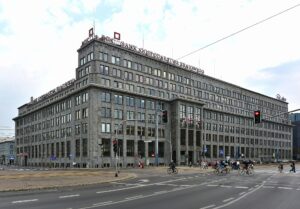 At this stage of the transformation project, we are noticing changes in the people who have gone through the whole program. Department directors who are already very able to consciously define their development goals, both in their personal sphere – I as a person – and in their sphere of responsibility. They know that they are able to work on their habits and know how to change these habits. They know that development and learning are embedded in their entire life process. They take a conscious approach to setting goals, to completing their tasks, and working with their subordinates. They know that the key role is to take care of themselves. And if they do not, they will not know how to take care of their team. Having talked to the participants, we learned that Maxwell was the first program to open their eyes, whereas the current program takes them “at least three levels higher.” It is a completely different level of awareness. We know that we were able to get this from the findings of the study using the ValueMatch survey.
At this stage of the transformation project, we are noticing changes in the people who have gone through the whole program. Department directors who are already very able to consciously define their development goals, both in their personal sphere – I as a person – and in their sphere of responsibility. They know that they are able to work on their habits and know how to change these habits. They know that development and learning are embedded in their entire life process. They take a conscious approach to setting goals, to completing their tasks, and working with their subordinates. They know that the key role is to take care of themselves. And if they do not, they will not know how to take care of their team. Having talked to the participants, we learned that Maxwell was the first program to open their eyes, whereas the current program takes them “at least three levels higher.” It is a completely different level of awareness. We know that we were able to get this from the findings of the study using the ValueMatch survey.
To quote a program participant: “Thanks to the ValueMatch personal report, I saw a picture of myself and how I see the organization. What kind of change process I am in and what is crucial for me today to keep growing. What might cause this development to stall or cause me to become frustrated and perhaps have to leave the organisation. I was able to look at myself and those factors that are favorable to me today and build my strength, but also to look at those areas that are preventing me from developing fully and unlocking my potential.”
WHY DID WE UNDERTAKE THE CULTURAL TRANSFORMATION?
Our experience of working for several years on shaping organizational culture at Bank Gospodarstwa Krajowego confirms that there is no implementation of business strategy without cultural transformation. The values that underpin a company’s culture are integral to the mission, vision, and strategy of any organization. We know this very well and we have great satisfaction from working on the organizational culture, especially because we worked on it together: the board of directors, HR, management and employees.
And the result – more than 90 percent of workers in an employee opinion survey say that the bank is effectively fulfilling its mission and strategic goals, and they are proud to work for Bank Gospodarstwa Krajowego.
 | ZUZANNA PIASECKA Director of the HR Department at Bank Gospodarstwa Krajowego, President of the “Empiria i Wiedza” Foundation, mentor and coach |
 | ZUZANNA PIASECKA Director of the HR Department at Bank Gospodarstwa Krajowego, President of the “Empiria i Wiedza” Foundation, mentor and coach |
 | NIKOLAY KIROV President of Kirov Strategic Negotiators, representative of ValueMatch in Poland, advisor, trainer, and mentor in the field of leadership, organizational culture transformation, negotiation and relationship building as well as management of self and the energy of managers |


